Paper Menu >>
Journal Menu >>
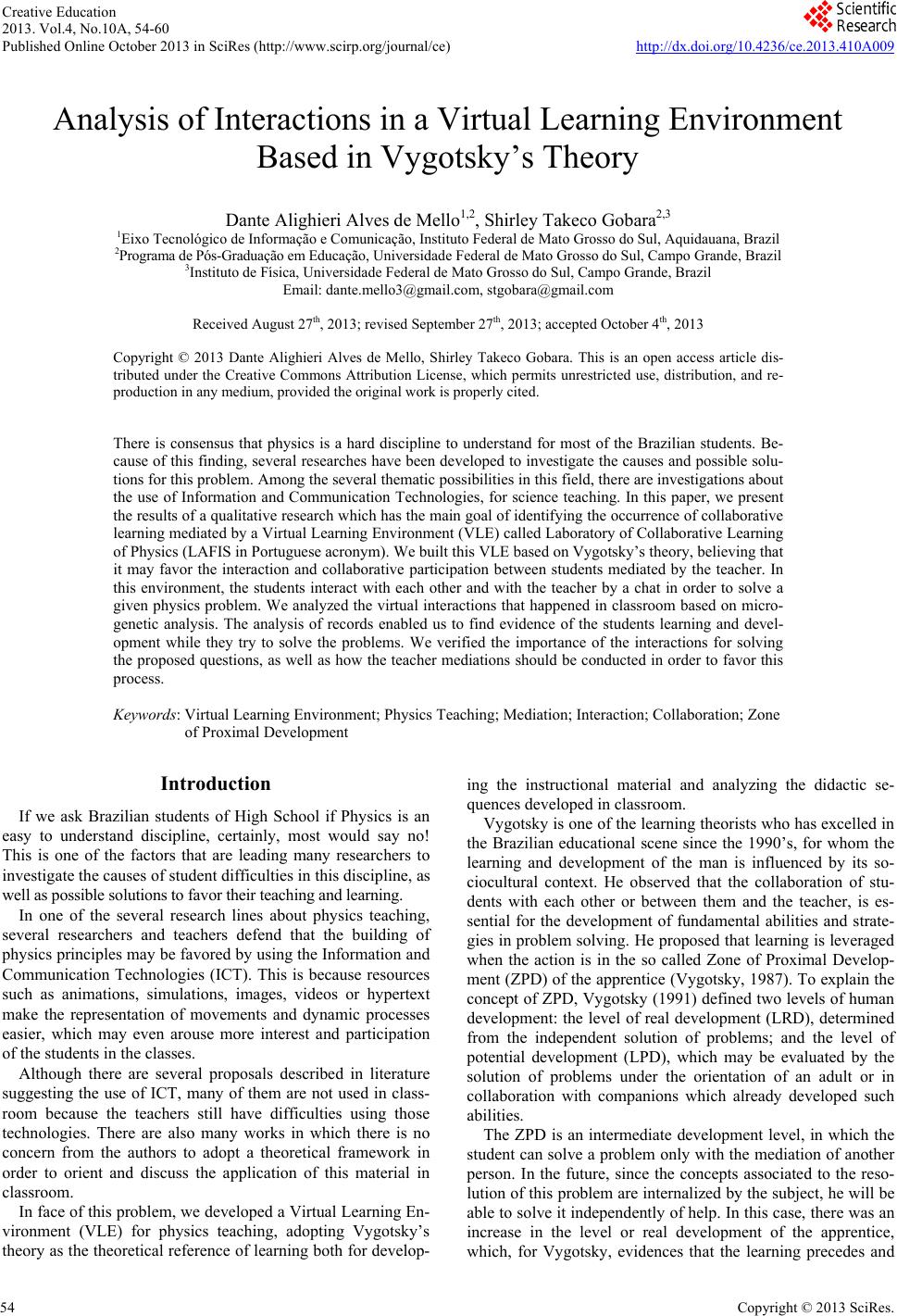 Creative Education 2013. Vol.4, No.10A, 54-60 Published Online October 2013 in SciRes (http://www.scirp.org/journal/ce) http://dx.doi.org/10.4236/ce.2013.410A009 Copyright © 2013 SciRes. 54 Analysis of Interactions in a Virtual Learning Environment Based in Vygotsky’s Theory Dante Alighieri Alves de Mello1,2, Shirley Takeco Gobara2,3 1Eixo Tecnológico de Informação e Comunicação, Instituto Federal de Mato Grosso do Sul, Aquidauana, Brazil 2Program a d e Pós- Gra duação em E d ucação, Universidade Federal de Mato Grosso do Sul, Campo Grande, Brazil 3Instituto de Física, Universidade Federal de Mato Grosso do Sul, Cam po Grande, Brazil Email: dante.mello3@gmail.com, stgobara@gmail.com Received August 27th, 2013; revised September 27th, 2013; accepted October 4th, 2013 Copyright © 2013 Dante Alighieri Alves de Mello, Shirley Takeco Gobara. This is an open access article dis- tributed under the Creative Commons Attribution License, which permits unrestricted use, distribution, and re- production in any medium, p rovided the original work is properly cited. There is consensus that physics is a hard discipline to understand for most of the Brazilian students. Be- cause of this finding, several researches have been developed to investigate the causes and possible solu- tions for this problem. Among the several thematic possibilities in this field, there are investigations about the use of Information and Communication Technologies, for science teaching. In this paper, we present the results of a qualitative research which has the main goal of identifying the occurrence of collaborative learning mediated by a Virtual Learning Environment (VLE) called Laboratory of Collaborative Learning of Physics (LAFIS in Portuguese acronym). We built this VLE based on Vygotsky’s theory, believing that it may favor the interaction and collaborative participation between students mediated by the teacher. In this environment, the students interact with each other and with the teacher by a chat in order to solve a given physics problem. We analyzed the virtual interactions that happened in classroom based on micro- genetic analysis. The analysis of records enabled us to find evidence of the students learning and devel- opment while they try to solve the problems. We verified the importance of the interactions for solving the proposed questions, as well as how the teacher mediations should be conducted in order to favor this process. Keywords: Virtual Learning Environment; Physics Teaching; Mediation; Interaction; Collaboration; Zone of Proximal Development Introduction If we ask Brazilian students of High School if Physics is an easy to understand discipline, certainly, most would say no! This is one of the factors that are leading many researchers to investigate the causes of student difficulties in this discipline, as well as possible solutions to favor their teaching and learning. In one of the several research lines about physics teaching, several researchers and teachers defend that the building of physics principles may be favored by using the Information and Communication Technologies (ICT). This is because resources such as animations, simulations, images, videos or hypertext make the representation of movements and dynamic processes easier, which may even arouse more interest and participation of the students in the classes. Although there are several proposals described in literature suggesting the use of ICT, many of them are not used in class- room because the teachers still have difficulties using those technologies. There are also many works in which there is no concern from the authors to adopt a theoretical framework in order to orient and discuss the application of this material in classroom. In face of this problem, we developed a Virtual Learning En- vironment (VLE) for physics teaching, adopting Vygotsky’s theory as the theoretical reference of learning both for develop- ing the instructional material and analyzing the didactic se- quences developed in classroom. Vygotsky is one of the learning theorists who has excelled in the Brazilian educational scene since the 1990’s, for whom the learning and development of the man is influenced by its so- ciocultural context. He observed that the collaboration of stu- dents with each other or between them and the teacher, is es- sential for the development of fundamental abilities and strate- gies in problem solving. He proposed that learning is leveraged when the action is in the so called Zone of Proximal Develop- ment (ZPD) of the apprentice (Vygotsky, 1987). To explain the concept of ZPD, Vygotsky (1991) defined two levels of human development: the level of real development (LRD), determined from the independent solution of problems; and the level of potential development (LPD), which may be evaluated by the solution of problems under the orientation of an adult or in collaboration with companions which already developed such abilities. The ZPD is an intermediate development level, in which the student can solve a problem only with the mediation of another person. In the future, since the concepts associated to the reso- lution of this problem are internalized by the subject, he will be able to solve it independently of help. In this case, there was an increase in the level or real development of the apprentice, which, for Vygotsky, evidences that the learning precedes and 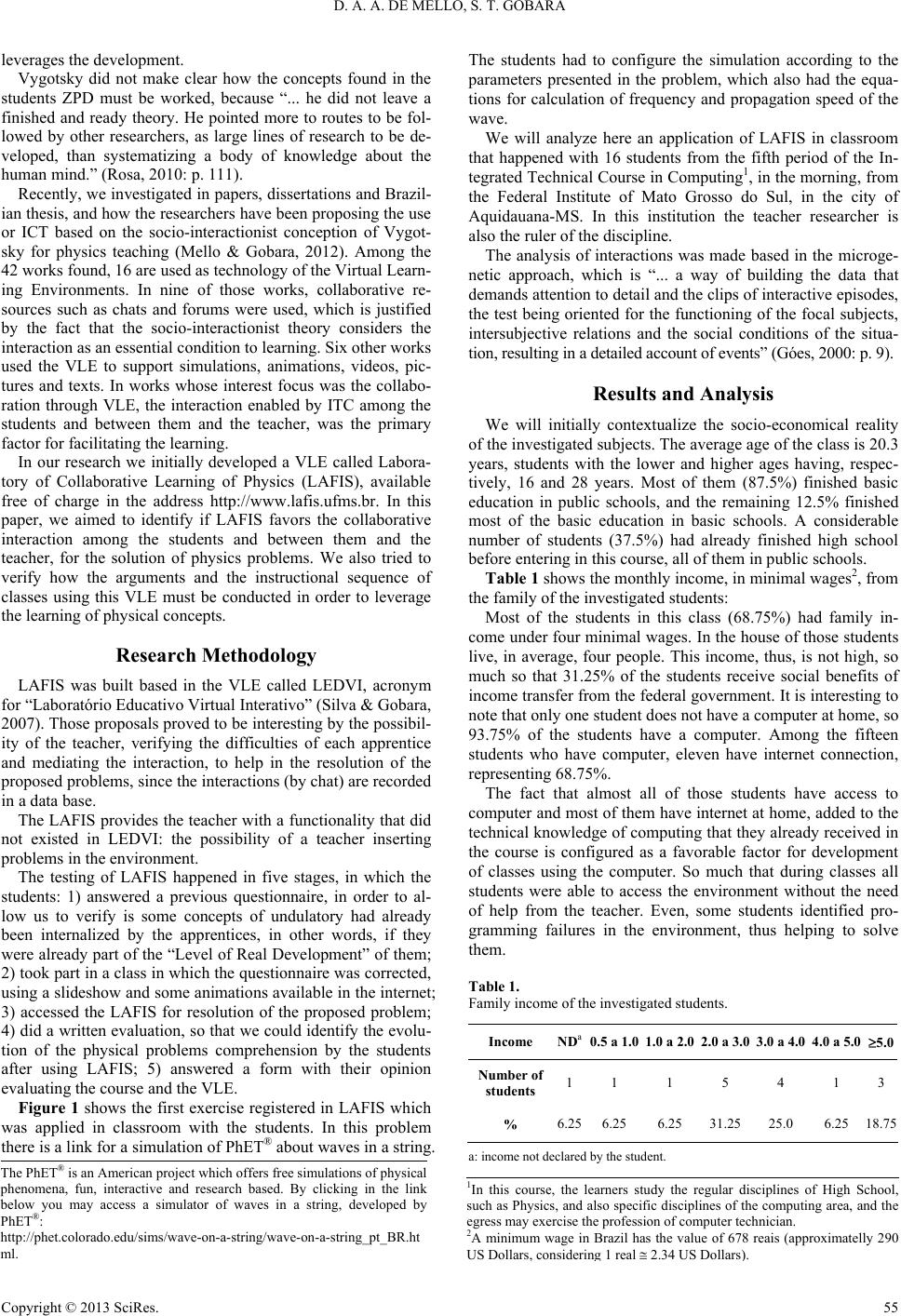 D. A. A. DE MELLO, S. T. GOBARA leverages the development. Vygotsky did not make clear how the concepts found in the students ZPD must be worked, because “... he did not leave a finished and ready theory. He pointed more to routes to be fol- lowed by other researchers, as large lines of research to be de- veloped, than systematizing a body of knowledge about the human mind.” (Rosa, 2010: p. 111). Recently, we investigated in papers, dissertations and Brazil- ian thesis, and how the researchers have been proposing the use or ICT based on the socio-interactionist conception of Vygot- sky for physics teaching (Mello & Gobara, 2012). Among the 42 works found, 16 are used as technology of the Virtual Learn- ing Environments. In nine of those works, collaborative re- sources such as chats and forums were used, which is justified by the fact that the socio-interactionist theory considers the interaction as an essential condition to learning. Six other works used the VLE to support simulations, animations, videos, pic- tures and texts. In works whose interest focus was the collabo- ration through VLE, the interaction enabled by ITC among the students and between them and the teacher, was the primary factor for facilitating the learning. In our research we initially developed a VLE called Labora- tory of Collaborative Learning of Physics (LAFIS), available free of charge in the address http://www.lafis.ufms.br. In this paper, we aimed to identify if LAFIS favors the collaborative interaction among the students and between them and the teacher, for the solution of physics problems. We also tried to verify how the arguments and the instructional sequence of classes using this VLE must be conducted in order to leverage the learning of physical concepts. Research Methodology LAFIS was built based in the VLE called LEDVI, acronym for “Laboratório Educativo Virtual Interativo” (Silva & Gobara, 2007). Those proposals proved to be interesting by the possibil- ity of the teacher, verifying the difficulties of each apprentice and mediating the interaction, to help in the resolution of the proposed problems, since the interactions (by chat) are recorded in a data base. The LAFIS provides the teacher with a functionality that did not existed in LEDVI: the possibility of a teacher inserting problems in the environment. The testing of LAFIS happened in five stages, in which the students: 1) answered a previous questionnaire, in order to al- low us to verify is some concepts of undulatory had already been internalized by the apprentices, in other words, if they were already part of the “Level of Real Development” of them; 2) took part in a class in which the questionnaire was corrected, using a slideshow and some animations available in the internet; 3) accessed the LAFIS for resolution of the proposed problem; 4) did a written evaluation, so that we could identify the evolu- tion of the physical problems comprehension by the students after using LAFIS; 5) answered a form with their opinion evaluating the course and the VLE. Figure 1 shows the first exercise registered in LAFIS which was applied in classroom with the students. In this problem there is a link for a simulation of PhET® about waves in a string. The students had to configure the simulation according to the parameters presented in the problem, which also had the equa- tions for calculation of frequency and propagation speed of the wave. We will analyze here an application of LAFIS in classroom that happened with 16 students from the fifth period of the In- tegrated Technical Course in Computing1, in the morning, from the Federal Institute of Mato Grosso do Sul, in the city of Aquidauana-MS. In this institution the teacher researcher is also the ruler of the discipline. The analysis of interactions was made based in the microge- netic approach, which is “... a way of building the data that demands attention to detail and the clips of interactive episodes, the test being oriented for the functioning of the focal subjects, intersubjective relations and the social conditions of the situa- tion, resulting in a detailed account of events” (Góes, 2000: p. 9). Results and Analysis We will initially contextualize the socio-economical reality of the investigated subjects. The average age of the class is 20.3 years, students with the lower and higher ages having, respec- tively, 16 and 28 years. Most of them (87.5%) finished basic education in public schools, and the remaining 12.5% finished most of the basic education in basic schools. A considerable number of students (37.5%) had already finished high school before entering in this course, all of them in public schools. Table 1 shows the monthly income, in minimal wages2, from the family of the investigated students: Most of the students in this class (68.75%) had family in- come under four minimal wages. In the house of those students live, in average, four people. This income, thus, is not high, so much so that 31.25% of the students receive social benefits of income transfer from the federal government. It is interesting to note that only one student does not have a computer at home, so 93.75% of the students have a computer. Among the fifteen students who have computer, eleven have internet connection, representing 68.75%. The fact that almost all of those students have access to computer and most of them have internet at home, added to the technical knowledge of computing that they already received in the course is configured as a favorable factor for development of classes using the computer. So much that during classes all students were able to access the environment without the need of help from the teacher. Even, some students identified pro- gramming failures in the environment, thus helping to solve them. Table 1. Family income of the investigated students. Income NDa0.5 a 1.01.0 a 2.0 2.0 a 3.0 3.0 a 4.0 4.0 a 5.05.0 Number of students 11 1 5 4 1 3 % 6.256.25 6.25 31.25 25.0 6.25 18.75 a: income not declared by the student. The PhET® is an American project which offers free simulations of physical p henomena, fun, interactive and research based. By clicking in the link b elow you may access a simulator of waves in a string, developed by PhET®: http://phet.colorado.edu/sims/wave-on-a-string/wave-on-a-string_pt_BR.ht ml. 1In this course, the learners study the regular disciplines of High School, such as P hysics, and also speci fic discipl ines of the co mputing area, and the egress may exercise the profession of computer technician. 2A minimum wage in Brazil has the value of 678 reais (approximatelly 290 US Dollars , conside r in g 1 real 2.34 US Dollars ) . Copyright © 2013 SciRes. 55 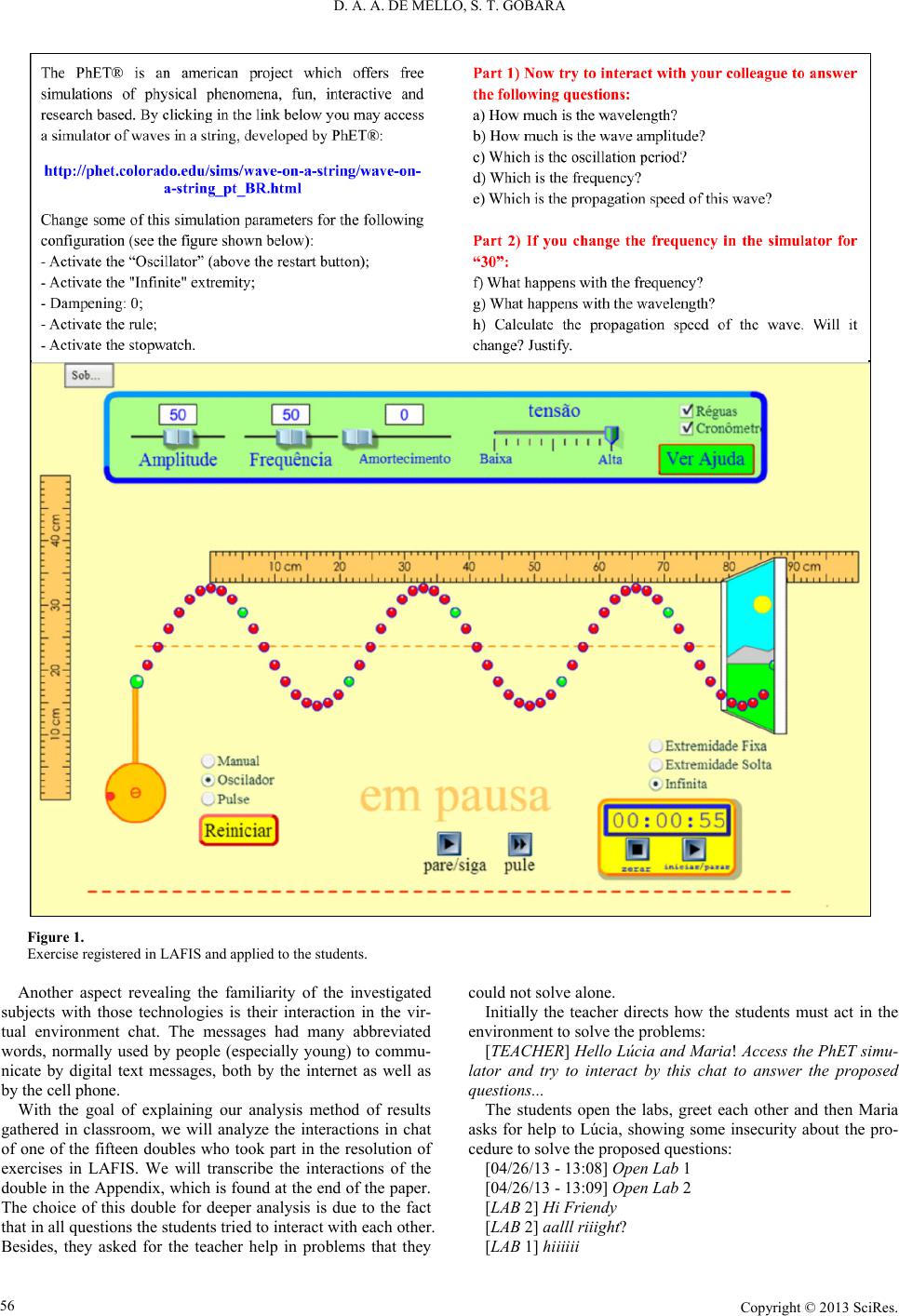 D. A. A. DE MELLO, S. T. GOBARA Copyright © 2013 SciRes. 56 Figure 1. Exercise registered in LAFIS and applied to the s tudents. Another aspect revealing the familiarity of the investigated subjects with those technologies is their interaction in the vir- tual environment chat. The messages had many abbreviated words, normally used by people (especially young) to commu- nicate by digital text messages, both by the internet as well as by the cell phone. With the goal of explaining our analysis method of results gathered in classroom, we will analyze the interactions in chat of one of the fifteen doubles who took part in the resolution of exercises in LAFIS. We will transcribe the interactions of the double in the Appendix, which is found at the end of the paper. The choice of this double for deeper analysis is due to the fact that in all questions the students tried to interact with each other. Besides, they asked for the teacher help in problems that they could not solve alone. Initially the teacher directs how the students must act in the environment to solve the problems: [TEACHER] Hello Lúcia and Maria! Access the PhET simu- lator and try to interact by this chat to answer the proposed questions... The students open the labs, greet each other and then Maria asks for help to Lúcia, showing some insecurity about the pro- cedure to solve the proposed questions: [04/26/13 - 13:08] Open Lab 1 [04/26/13 - 13:09] Open Lab 2 [LAB 2] Hi Friendy [LAB 2] aalll riiight? [LAB 1] hiiiiii 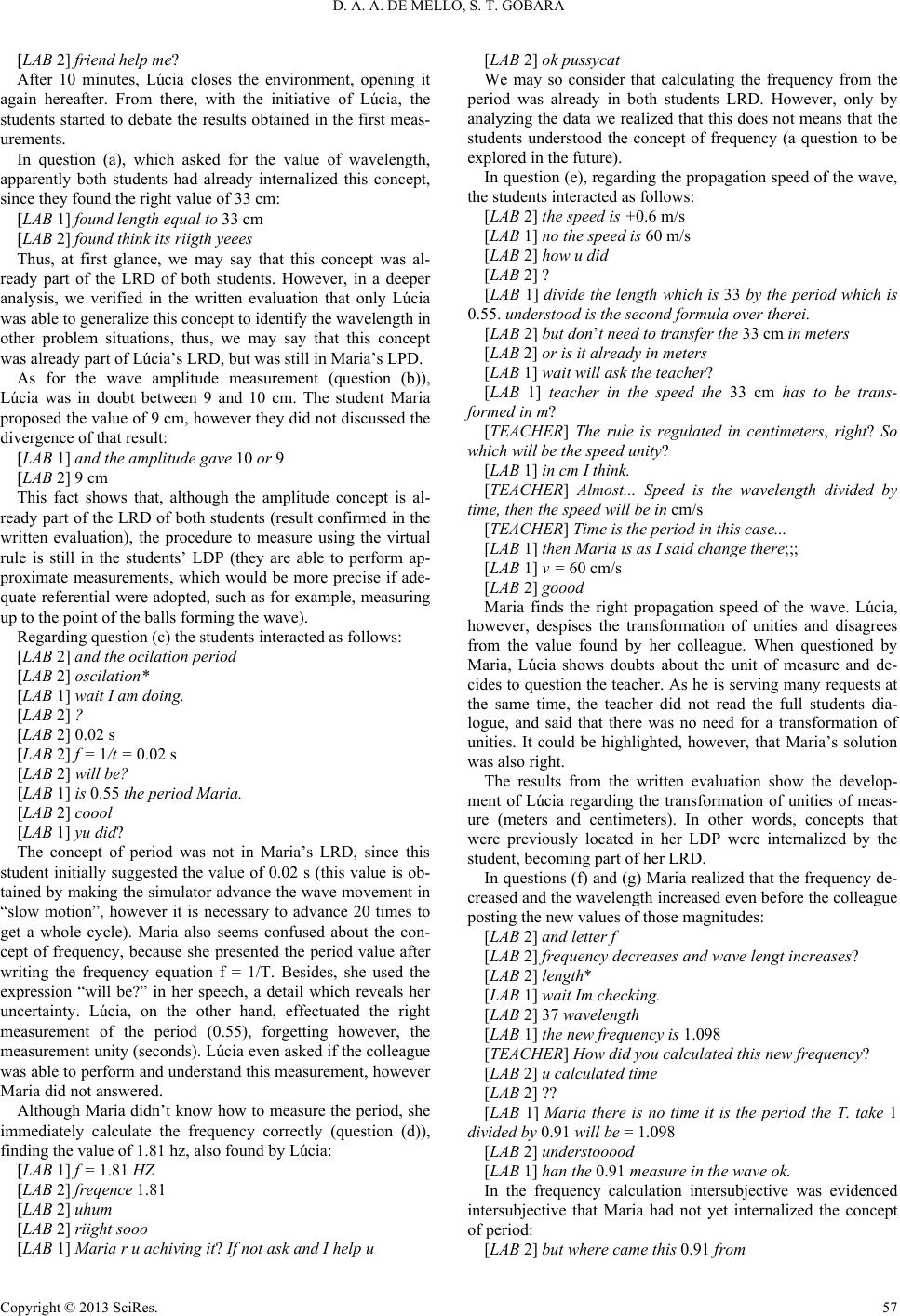 D. A. A. DE MELLO, S. T. GOBARA [LAB 2] friend help me? After 10 minutes, Lúcia closes the environment, opening it again hereafter. From there, with the initiative of Lúcia, the students started to debate the results obtained in the first meas- urements. In question (a), which asked for the value of wavelength, apparently both students had already internalized this concept, since they found the right value of 33 cm: [LAB 1] found length equal to 33 cm [LAB 2] found thin k i ts riigth yeees Thus, at first glance, we may say that this concept was al- ready part of the LRD of both students. However, in a deeper analysis, we verified in the written evaluation that only Lúcia was able to generalize this concept to identify the wavelength in other problem situations, thus, we may say that this concept was already part of Lúcia’s LRD, but was still in Maria’s LPD. As for the wave amplitude measurement (question (b)), Lúcia was in doubt between 9 and 10 cm. The student Maria proposed the value of 9 cm, however they did not discussed the divergence of that result: [LAB 1] and the amplitude gave 10 or 9 [LAB 2] 9 cm This fact shows that, although the amplitude concept is al- ready part of the LRD of both students (result confirmed in the written evaluation), the procedure to measure using the virtual rule is still in the students’ LDP (they are able to perform ap- proximate measurements, which would be more precise if ade- quate referential were adopted, such as for example, measuring up to the point of the balls forming the wave). Regarding question (c) the students interacted as follows: [LAB 2] and the ocilation period [LAB 2] oscilation* [LAB 1] wait I am doing. [LAB 2] ? [LAB 2] 0.02 s [LAB 2] f = 1/t = 0.02 s [LAB 2] will be? [LAB 1] is 0.55 the period Maria. [LAB 2] coool [LAB 1] yu did? The concept of period was not in Maria’s LRD, since this student initially suggested the value of 0.02 s (this value is ob- tained by making the simulator advance the wave movement in “slow motion”, however it is necessary to advance 20 times to get a whole cycle). Maria also seems confused about the con- cept of frequency, because she presented the period value after writing the frequency equation f = 1/T. Besides, she used the expression “will be?” in her speech, a detail which reveals her uncertainty. Lúcia, on the other hand, effectuated the right measurement of the period (0.55), forgetting however, the measurement unity (seconds). Lúcia even asked if the colleague was able to perform and understand this measurement, however Maria did not answered. Although Maria didn’t know how to measure the period, she immediately calculate the frequency correctly (question (d)), finding the value of 1.81 hz, also found by Lúcia: [LAB 1] f = 1.81 HZ [LAB 2] freqence 1.81 [LAB 2] uhum [LAB 2] riight sooo [LAB 1] Maria r u achiving it? If not ask and I help u [LAB 2] ok pussycat We may so consider that calculating the frequency from the period was already in both students LRD. However, only by analyzing the data we realized that this does not means that the students understood the concept of frequency (a question to be explored in the future). In question (e), regarding the propagation speed of the wave, the students interacted as follows: [LAB 2] the speed is +0.6 m/s [LAB 1] no the speed is 60 m/s [LAB 2] how u did [LAB 2] ? [LAB 1] divide the length which is 33 by the period which is 0.55. understood is the second formula over therei. [LAB 2] but don’t need to transfer the 33 cm in meters [LAB 2] or is it already in meters [LAB 1] wait will ask the teacher? [LAB 1] teacher in the speed the 33 cm has to be trans- formed in m? [TEACHER] The rule is regulated in centimeters, right? So which will be the speed unity? [LAB 1] in cm I think. [TEACHER] Almost... Speed is the wavelength divided by time, then the speed will be in cm/s [TEACHER] Time is the period in this case... [LAB 1] then Maria is as I said change there;;; [LAB 1] v = 60 cm/s [LAB 2] goood Maria finds the right propagation speed of the wave. Lúcia, however, despises the transformation of unities and disagrees from the value found by her colleague. When questioned by Maria, Lúcia shows doubts about the unit of measure and de- cides to question the teacher. As he is serving many requests at the same time, the teacher did not read the full students dia- logue, and said that there was no need for a transformation of unities. It could be highlighted, however, that Maria’s solution was also right. The results from the written evaluation show the develop- ment of Lúcia regarding the transformation of unities of meas- ure (meters and centimeters). In other words, concepts that were previously located in her LDP were internalized by the student, becoming part of her LRD. In questions (f) and (g) Maria realized that the frequency de- creased and the wavelength increased even before the colleague posting the new values of those magnitudes: [LAB 2] and letter f [LAB 2] frequency decreases and wave lengt increases? [LAB 2] length* [LAB 1] wait Im checking. [LAB 2] 37 wavelength [LAB 1] the new frequency is 1.098 [TEACHER] How did you calculated this new frequency? [LAB 2] u calculated time [LAB 2] ?? [LAB 1] Maria there is no time it is the period the T. take 1 divided by 0.91 will be = 1.098 [LAB 2] understooood [LAB 1] han the 0.91 measure in the wave ok. In the frequency calculation intersubjective was evidenced intersubjective that Maria had not yet internalized the concept of period: [LAB 2] but where came this 0.91 from Copyright © 2013 SciRes. 57 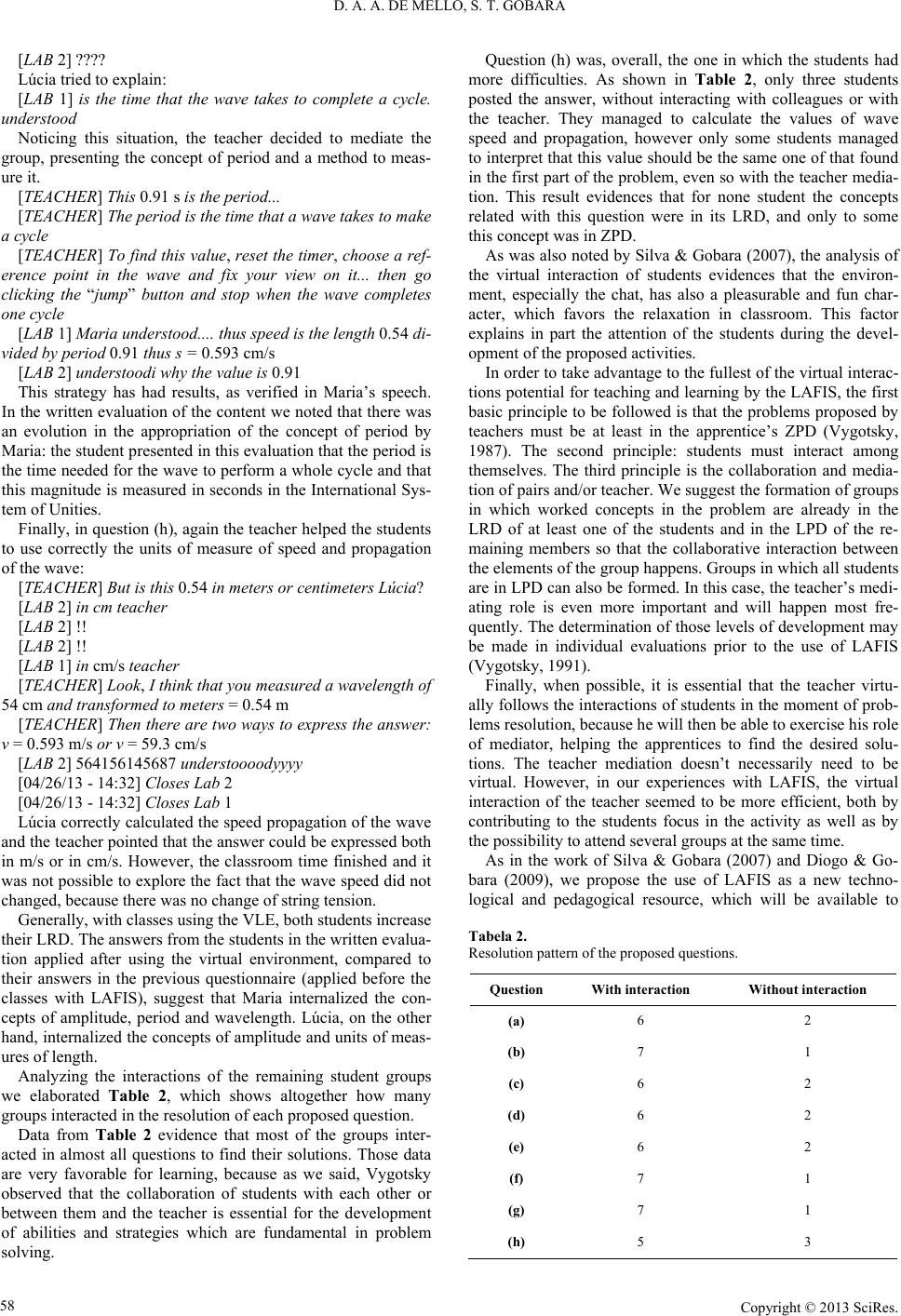 D. A. A. DE MELLO, S. T. GOBARA [LAB 2] ???? Lúcia tried to explain: [LAB 1] is the time that the wave takes to complete a cycle. understood Noticing this situation, the teacher decided to mediate the group, presenting the concept of period and a method to meas- ure it. [TEACHER] This 0.91 s is the period... [TEACHER] The period is the time that a wave takes to make a cycle [TEACHER] To find this value, reset the timer, choose a ref- erence point in the wave and fix your view on it... then go clicking the “jump” button and stop when the wave completes one cycle [LAB 1] Maria understood.... thus speed is the length 0.54 di- vided by period 0.91 thus s = 0.593 cm/s [LAB 2] understoodi why the value is 0.91 This strategy has had results, as verified in Maria’s speech. In the written evaluation of the content we noted that there was an evolution in the appropriation of the concept of period by Maria: the student presented in this evaluation that the period is the time needed for the wave to perform a whole cycle and that this magnitude is measured in seconds in the International Sys- tem of Unities. Finally, in question (h), again the teacher helped the students to use correctly the units of measure of speed and propagation of the wave: [TEACHER] But is this 0.54 in meters or centimeters Lúcia? [LAB 2] in cm teacher [LAB 2] !! [LAB 2] !! [LAB 1] in cm/s teacher [TEACHER] Look, I think that you measured a wavelength of 54 cm and transformed to meters = 0.54 m [TEACHER] Then there are two ways to express the answer: v = 0.593 m/s or v = 59.3 cm/s [LAB 2] 564156145687 understoooodyyyy [04/26/13 - 14:32] Closes Lab 2 [04/26/13 - 14:32] Closes Lab 1 Lúcia correctly calculated the speed propagation of the wave and the teacher pointed that the answer could be expressed both in m/s or in cm/s. However, the classroom time finished and it was not possible to explore the fact that the wave speed did not changed, because there was no change of string tension. Generally, wi t h cl asses using the VLE, both students increase their LRD. The answers from the students in the written evalua- tion applied after using the virtual environment, compared to their answers in the previous questionnaire (applied before the classes with LAFIS), suggest that Maria internalized the con- cepts of amplitude, period and wavelength. Lúcia, on the other hand, internalized the concepts of amplitude and units of meas- ures of length. Analyzing the interactions of the remaining student groups we elaborated Table 2, which shows altogether how many groups interacted in the resolution of each proposed question. Data from Table 2 evidence that most of the groups inter- acted in almost all questions to find their solutions. Those data are very favorable for learning, because as we said, Vygotsky observed that the collaboration of students with each other or between them and the teacher is essential for the development of abilities and strategies which are fundamental in problem solving. Question (h) was, overall, the one in which the students had more difficulties. As shown in Table 2, only three students posted the answer, without interacting with colleagues or with the teacher. They managed to calculate the values of wave speed and propagation, however only some students managed to interpret that this value should be the same one of that found in the first part of the problem, even so with the teacher media- tion. This result evidences that for none student the concepts related with this question were in its LRD, and only to some this concept was in ZPD. As was also noted by Silva & Gobara (2007), the analysis of the virtual interaction of students evidences that the environ- ment, especially the chat, has also a pleasurable and fun char- acter, which favors the relaxation in classroom. This factor explains in part the attention of the students during the devel- opment of the proposed activities. In order to take advantage to the fullest of the virtual interac- tions potential for teaching and learning by the LAFIS, the first basic principle to be followed is that the problems proposed by teachers must be at least in the apprentice’s ZPD (Vygotsky, 1987). The second principle: students must interact among themselves. The third principle is the collaboration and media- tion of pairs and/or teacher. We suggest the formation of groups in which worked concepts in the problem are already in the LRD of at least one of the students and in the LPD of the re- maining members so that the collaborative interaction between the elements of the group happens. Groups in which all students are in LPD can also be formed. In this case, the teacher’s medi- ating role is even more important and will happen most fre- quently. The determination of those levels of development may be made in individual evaluations prior to the use of LAFIS (Vygotsky, 1991). Finally, when possible, it is essential that the teacher virtu- ally follows the interactions of students in the moment of prob- lems resolution, because he will then be able to exercise his role of mediator, helping the apprentices to find the desired solu- tions. The teacher mediation doesn’t necessarily need to be virtual. However, in our experiences with LAFIS, the virtual interaction of the teacher seemed to be more efficient, both by contributing to the students focus in the activity as well as by the possibility to attend several groups at the same time. As in the work of Silva & Gobara (2007) and Diogo & Go- bara (2009), we propose the use of LAFIS as a new techno- logical and pedagogical resource, which will be available to Tabela 2. Resolution pattern of the proposed questions. Question With interaction Without interaction (a) 6 2 (b) 7 1 (c) 6 2 (d) 6 2 (e) 6 2 (f) 7 1 (g) 7 1 (h) 5 3 Copyright © 2013 SciRes. 58 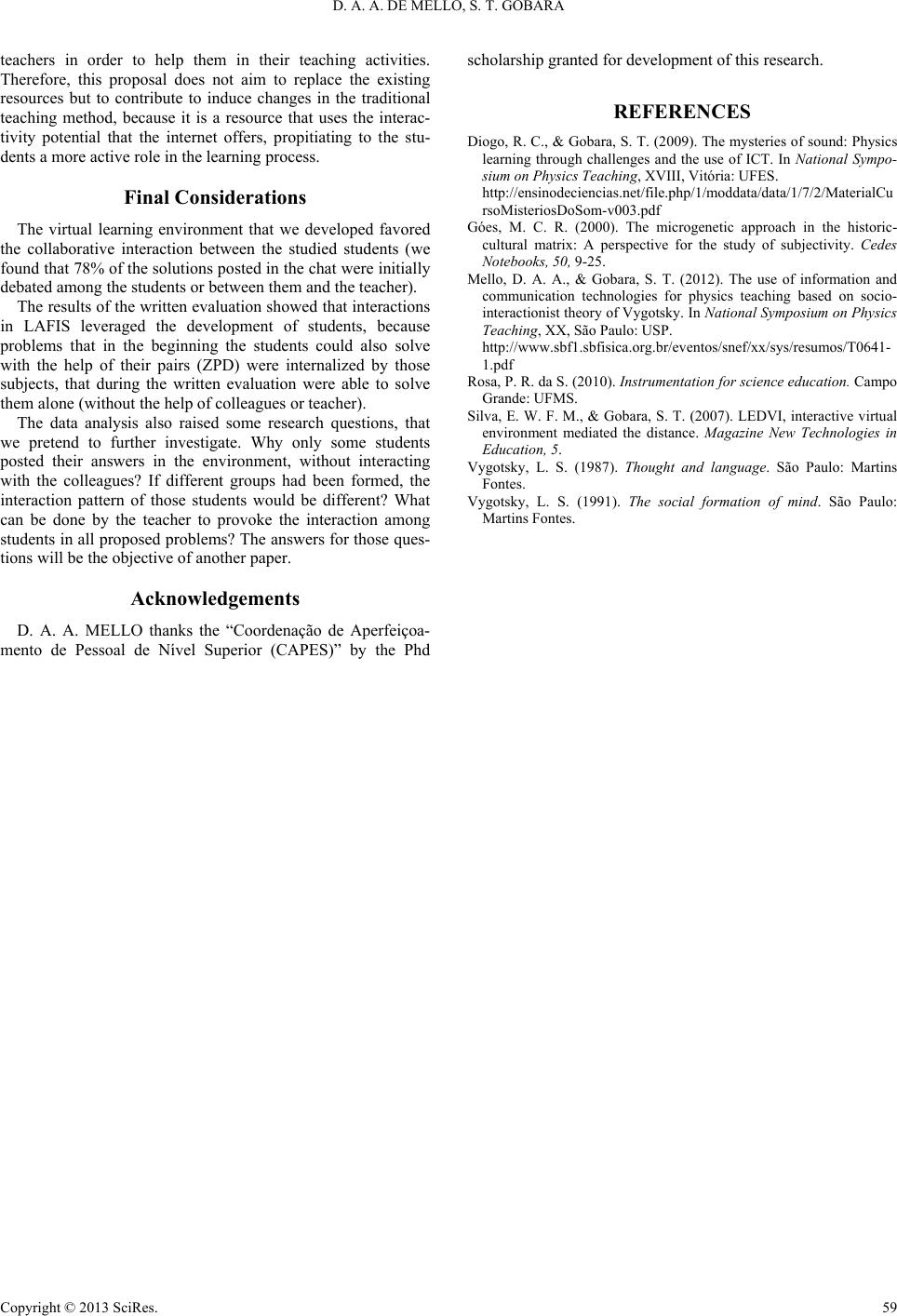 D. A. A. DE MELLO, S. T. GOBARA Copyright © 2013 SciRes. 59 teachers in order to help them in their teaching activities. Therefore, this proposal does not aim to replace the existing resources but to contribute to induce changes in the traditional teaching method, because it is a resource that uses the interac- tivity potential that the internet offers, propitiating to the stu- dents a more active role in the learning process. Final Considerations The virtual learning environment that we developed favored the collaborative interaction between the studied students (we found that 78% of the solutions posted in the chat were initially debated among the students or between them and the teacher). The results of the written evaluation showed that interactions in LAFIS leveraged the development of students, because problems that in the beginning the students could also solve with the help of their pairs (ZPD) were internalized by those subjects, that during the written evaluation were able to solve them alone (without the help of colleagues or teacher). The data analysis also raised some research questions, that we pretend to further investigate. Why only some students posted their answers in the environment, without interacting with the colleagues? If different groups had been formed, the interaction pattern of those students would be different? What can be done by the teacher to provoke the interaction among students in all proposed problems? The answers for those ques- tions will be the objective of another paper. Acknowledgements D. A. A. MELLO thanks the “Coordenação de Aperfeiçoa- mento de Pessoal de Nível Superior (CAPES)” by the Phd scholarship granted for development of this research. REFERENCES Diogo, R. C., & Gobara, S. T. (2009). The mysteries of sound: Physics learning through challenges and the use of ICT. In National Sympo- sium on Physics Teaching, XVIII, Vitória: UFES. http://ensinodeciencias.net/file.php/1/moddata/data/1/7/2/MaterialCu rsoMisteriosDoSom-v003.pdf Góes, M. C. R. (2000). The microgenetic approach in the historic- cultural matrix: A perspective for the study of subjectivity. Cedes Notebooks, 50, 9-25. Mello, D. A. A., & Gobara, S. T. (2012). The use of information and communication technologies for physics teaching based on socio- interactionist theory of Vygotsky. In National Symposium on Physics Teaching, XX, São Paulo: USP. http://www.sbf1.sbfisica.org.br/eventos/snef/xx/sys/resumos/T0641- 1.pdf Rosa, P. R. da S. (2010). Instrumentation for science education. Campo Grande: UFMS. Silva, E. W. F. M., & Gobara, S. T. (2007). LEDVI, interactive virtual environment mediated the distance. Magazine New Technologies in Education, 5. Vygotsky, L. S. (1987). Thought and language. São Paulo: Martins Fontes. Vygotsky, L. S. (1991). The social formation of mind. São Paulo: Martins Fontes. 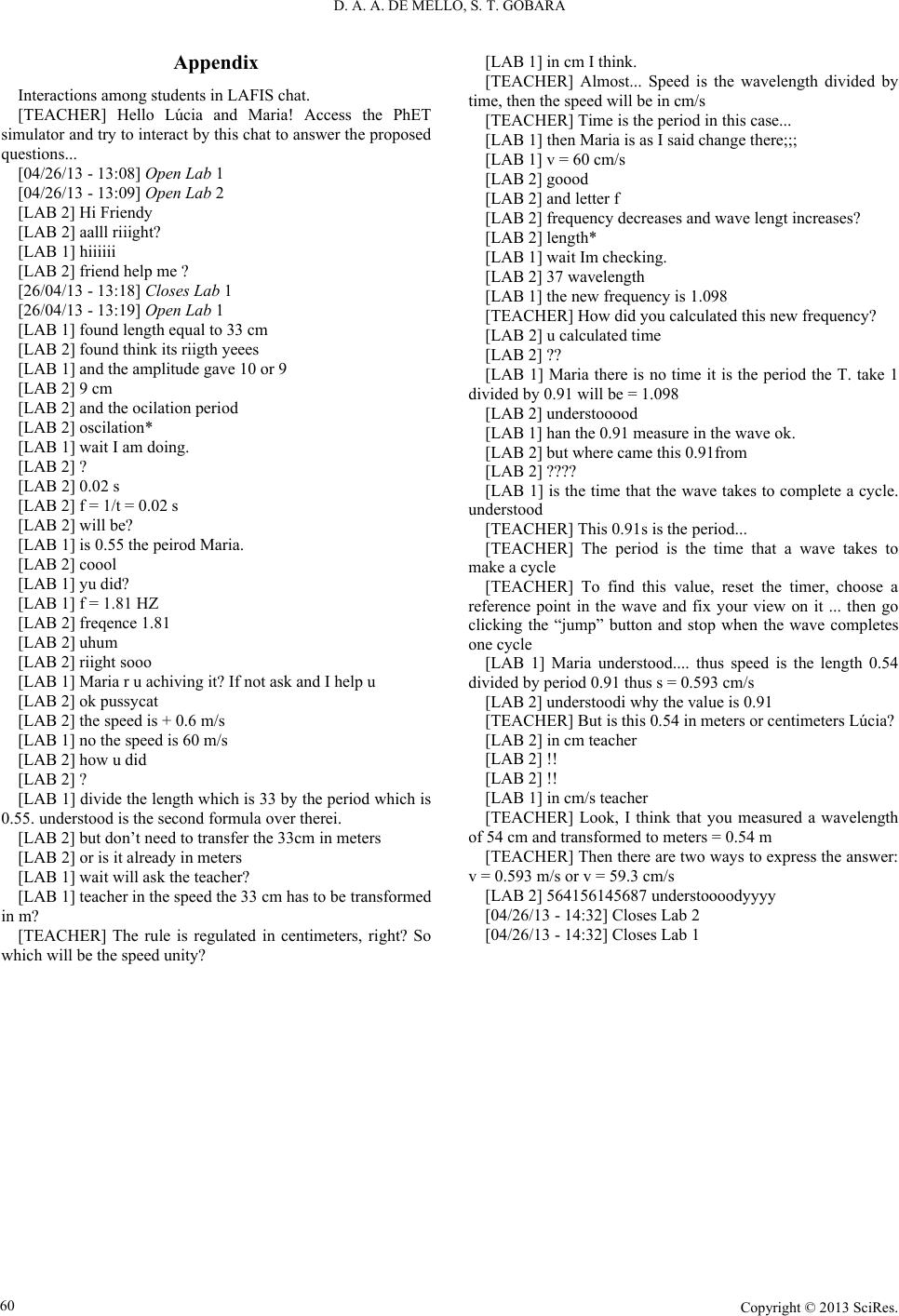 D. A. A. DE MELLO, S. T. GOBARA Appendix Interactions among students in LAFIS chat. [TEACHER] Hello Lúcia and Maria! Access the PhET simulator and try to interact by this chat to answer the proposed questions... [04/26/13 - 13:08] Open Lab 1 [04/26/13 - 13:09] Open Lab 2 [LAB 2] Hi Friendy [LAB 2] aalll riiight? [LAB 1] hiiiiii [LAB 2] friend help me ? [26/04/13 - 13:18] Closes Lab 1 [26/04/13 - 13:19] Open Lab 1 [LAB 1] found length equal to 33 cm [LAB 2] found think its riigth yeees [LAB 1] and the amplitude gave 10 or 9 [LAB 2] 9 cm [LAB 2] and the ocilation period [LAB 2] oscilation* [LAB 1] wait I am doing. [LAB 2] ? [LAB 2] 0.02 s [LAB 2] f = 1/t = 0.02 s [LAB 2] will be? [LAB 1] is 0.55 the peirod Maria. [LAB 2] coool [LAB 1] yu did? [LAB 1] f = 1.81 HZ [LAB 2] freqence 1.81 [LAB 2] uhum [LAB 2] riight sooo [LAB 1] Maria r u achiving it? If not ask and I help u [LAB 2] ok pussycat [LAB 2] the speed is + 0.6 m/s [LAB 1] no the speed is 60 m/s [LAB 2] how u did [LAB 2] ? [LAB 1] divide the length which is 33 by the period which is 0.55. understood is the second formula over therei. [LAB 2] but don’t need to transfer the 33cm in meters [LAB 2] or is it already in meters [LAB 1] wait will ask the teacher? [LAB 1] teacher in the speed the 33 cm has to be transformed in m? [TEACHER] The rule is regulated in centimeters, right? So which will be the speed unity? [LAB 1] in cm I think. [TEACHER] Almost... Speed is the wavelength divided by time, then the speed will be in cm/s [TEACHER] Time is the period in this case... [LAB 1] then Maria is as I said change there;;; [LAB 1] v = 60 cm/s [LAB 2] goood [LAB 2] and letter f [LAB 2] frequency decreases and wave lengt increases? [LAB 2] length* [LAB 1] wait Im checking. [LAB 2] 37 wavelength [LAB 1] the new frequency is 1.098 [TEACHER] How did you calculated this new frequency? [LAB 2] u calculated time [LAB 2] ?? [LAB 1] Maria there is no time it is the period the T. take 1 divided by 0.91 will be = 1.098 [LAB 2] understooood [LAB 1] han the 0.91 measure in the wave ok. [LAB 2] but where came this 0.91from [LAB 2] ???? [LAB 1] is the time that the wave takes to complete a cycle. understood [TEACHER] This 0.91s is the period... [TEACHER] The period is the time that a wave takes to make a cycle [TEACHER] To find this value, reset the timer, choose a reference point in the wave and fix your view on it ... then go clicking the “jump” button and stop when the wave completes one cycle [LAB 1] Maria understood.... thus speed is the length 0.54 divided by period 0.91 thus s = 0.593 cm/s [LAB 2] understoodi why the value is 0.91 [TEACHER] But is this 0.54 in meters or centimeters Lúcia? [LAB 2] in cm teacher [LAB 2] !! [LAB 2] !! [LAB 1] in cm/s teacher [TEACHER] Look, I think that you measured a wavelength of 54 cm and transformed to meters = 0.54 m [TEACHER] Then there are two ways to express the answer: v = 0.593 m/s or v = 59.3 cm/s [LAB 2] 564156145687 understoooodyyyy [04/26/13 - 14:32] Closes Lab 2 [04/26/13 - 14:32] Closes Lab 1 Copyright © 2013 SciRes. 60 |

